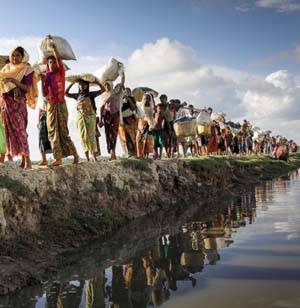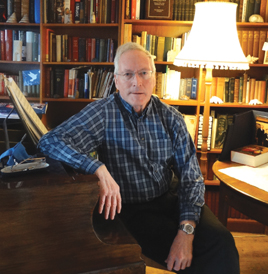I remember dancing along with the Hare Krishnas on the streets of Auckland in 1973. The most visible of the religious groups that mushroomed during the 1960s and 70s, they were known for their chanting, shaved heads and saffron robes. For me they were the ultimate rebellion, the finger up at authority and the 'establishment'. I was a new devotee of Eastern mysticism (yes I was lost, naïve and idealistic) and even though I did not join that particular group, I could well have done. They seemed a bit extreme but I regarded myself as not quite ready for the austere, 'pure' lifestyle that the Hare Krishnas demanded. How ironic, then, that of all the religious sects spawned from the counterculture movement, the Hare Krishnas (also called International Society for Krishna Consciousness ' ISKCON) ended up being one of the most authoritarian. It also ended up being one of the most abusive to the children in its care.
On 23 May 2005, the United States bankruptcy court approved a plan for ISKCON to pay $9.5 million in damages to former students who had suffered sexual, physical and emotional abuse during the 1970s and 80s. Even though a majority of claimants had to vote for the plan in order for the court to accept it, there have been reports that many did so grudgingly, because they thought they would miss out otherwise. Regardless, a total of 550 plaintiffs will receive amounts ranging from $2,500 to $50,000 each (depending on the severity of the abuse) with disbursements beginning in September 2005 and the bulk of compensation to be paid by 2011.
The case was originally filed at a federal court in Dallas, Texas, in 2000 on behalf of 90 students with a claim for $400 million. At the time, the plaintiffs' lawyer Windle Turley said: 'This lawsuit describes the most unthinkable abuse and maltreatment of little children as we have seen. [...] As a result, a generation of ISKCON children are permanently, and many profoundly, injured. It is estimated that more than one thousand children as young as three years of age suffered neglect, emotional, physical and sexual abuse. A number have already taken their own lives.'
Unlike other Hindu-derived sects such as the Sathya Sai Baba and Muktananda groups, who have had similar allegations made against them, ISKCON has not disputed the abuse claims. In fact, some members have been very active in bringing the issue into the open. They even commissioned Burke Rochford, a sociology professor at Vermont University, to investigate the allegations, and published his report in 1998. For some years a Child Protection Office was set up to investigate cases of alleged child abuse (a list of 200 alleged abusers was complied) and to help temples and schools establish child protection teams and screening systems.
So what happened to the victims and why did it take so long for these allegations to be brought into the open?
Most of the abuse took place in ashram-based gurukulas (Sanskrit for school of the guru), in particular those in India but also in several schools in the United States. During the 1970s and 80s parents were encouraged to send their children to these schools from the age of three. Most were discouraged from visiting or forming close bonds with their children as parental attachments (along with material possessions) were regarded as 'illusionary' and hence would prevent them from doing the work of Krishna ' the god of love in the Hindu pantheon. They were however expected to raise money for the organisation, but little of this went to running the schools. Their children were taught that in the spiritual world there were no parents, only souls and hence this justified their being kept out of view from others, cloistered in separate buildings and sheltered from the 'evil material world'.
From court documents lodged by Turley and reports from ISKCON itself, what happened during those years is horrifying. Children suffered broken noses, serious bruises and contusions, lost teeth from being beaten with clubs and fists and also from being kicked. A number had their ears slapped so severely that bleeding and loss of hearing occurred. Medical care was sometimes denied, even for malaria, hepatitis and broken bones. Children did not receive proper food and some report they 'were always hungry' and had to eat leftovers or insect-infested food. If they vomited they had to eat their own vomit; if they wet their beds they were forced to drink urine and wear soiled underwear on their heads. Apart from physical beatings they were also punished by being shut in closets, refrigerators or trash bins for hours, even days at a time. Some schools were filthy and overcrowded: children slept on the floor, often in sleeping bags. There was no TV, radio, toys or games. Some children were raped every day for years and there were arranged marriages between girls as young as eleven to men twice or thrice their age.
The perpetrators of these crimes were none other than teachers, administrators, and, in some cases, ISKCON leaders. It was not uncommon for the children to be told they were being treated this way because it was their bad karma and they must have hurt a child in a past life.
The leader of the group, Indian-born Sri Prabhupada, was told of the abuse as early as 1972 but evidently did nothing to stop it. After he died in 1977, leadership was passed on to eleven male disciples, called gurus, and the abuse continued. Nori Muster, former devotee and author of Betrayal of the Spirit, claims: 'If parents tried to speak up, the gurus either silenced them or kicked them out. Some parents just pulled their kids out and left the organisation. Also, many parents abused their children, since they were low on parenting skills and violence was a way of life in ISKCON.'
In 1988 one of the mothers wrote to ISKCON's minister of education regarding the abuse of her son at one of the smaller schools. 'A total of five children are known to have been abused to some degree. Penetration had been attempted and oral sex had been done repeatedly to the degree of seminal discharge into the mouth with a condom. It seems it had all been going on for a year and a half with no one suspecting it. The real horror of all this is that they were abused in the holy dharma by teachers, monitors, etc. And the children were even witnessing a guru doing it to boys. It seems it had been very rampant and 'just a part of life there'. You were either forced to engage in it or you observed it around you.' Her letter was ignored.
Finally a few autobiographical essays were published and gurukula reunions held where survivors began to talk about what had happened, but it wasn't until the late 1990s that these stories reached the media, at about the time that stories of abuse within a range of other religious organisations (including the Catholic and Anglican churches) were aired.
The world of academia hasn't helped. What is astonishing is that over the past 20 years there has been a tendency among academics to give more weight to the statements of members and leaders than to claims by former members and the media. The late Dr Bryan Wilson, a sociologist of religion at Oxford University, once wrote: 'Neither the objective sociological researcher nor the court of law can readily regard the apostate as a credible or reliable source of evidence.' In what other sort of crime is a victim not a credible or reliable source of evidence?
Professor Beit-Hallahmi of Haifa University challenges this 'supportive collaborative majority' and points out that allegations by outsiders and detractors have been closer to reality than any other accounts. Ever since the Jonestown tragedy, statements by ex-members turned out to be more accurate than those of apologists and academic researchers. He points out that the reality revealed in the cases of the Rajneeshees, the Branch Davidians, Aum Shinrikyo, Solar Temple, or Heaven's Gate is positively horrifying as in these 'we encounter a hidden world of madness and exploitation in a totalitarian, psychotic, group, whose reality is actually even worse than detractors' allegations'.
Research on child abuse suggests that religious beliefs can foster, encourage, and justify the abuse of children. When contempt for sex underlies teachings ' as it does in some traditional and new age religions ' this creates a breeding ground for abuse. Abuse is widespread in some of the guru-based groups in India, which is understandable given the fact that gurus are often considered to be vehicles of God ' if not God incarnate ' hence one should not question or doubt them, let alone judge them. Some devotees regard their leaders as operating on a level beyond good and evil!
ISKCON has now developed a zero tolerance attitude towards child abuse. To safeguard children, teacher Karuna Purna claims on the website chakra.org that it is now 'absolutely forbidden for school staff to have any physical contact with any pupil under any circumstance. Not even a gentle hand on a shoulder when they did well or to make a queue move faster.'
Unlike some mainstream religious groups, such as the Catholic church, which have been responsible for appalling cases of child abuse, it is clear that a small group within ISKCON has worked tirelessly over the years to bring the issue of child abuse out into the open and bring some justice to the victims. At the conclusion of the court case, spokesman Anuttama Dasa announced: 'It is heartbreaking that many of our children were abused. On behalf of our entire society, I apologise to these young people. I pray that someday they will be able to forgive us. And, I pray that today's agreement will help them heal and move forward in their lives.'
From personal experience I can say that for the survivors the major hurdle is yet to come: realising that the abuse was not their fault. Or as ISKCON would put it, their karma.
Mary Garden is a freelance writer from Queensland, Australia. She is the author of The Serpent Rising ' a journey of spiritual seduction, based on her experiences in India during the 1970s. This book is now available for AUS$19.95 post-free anywhere in the world from www.marygarden.net

